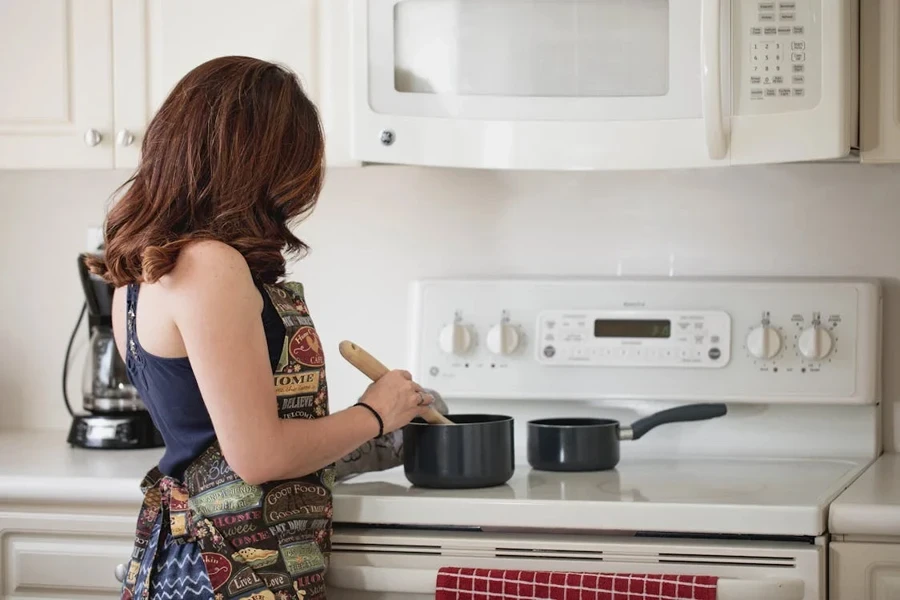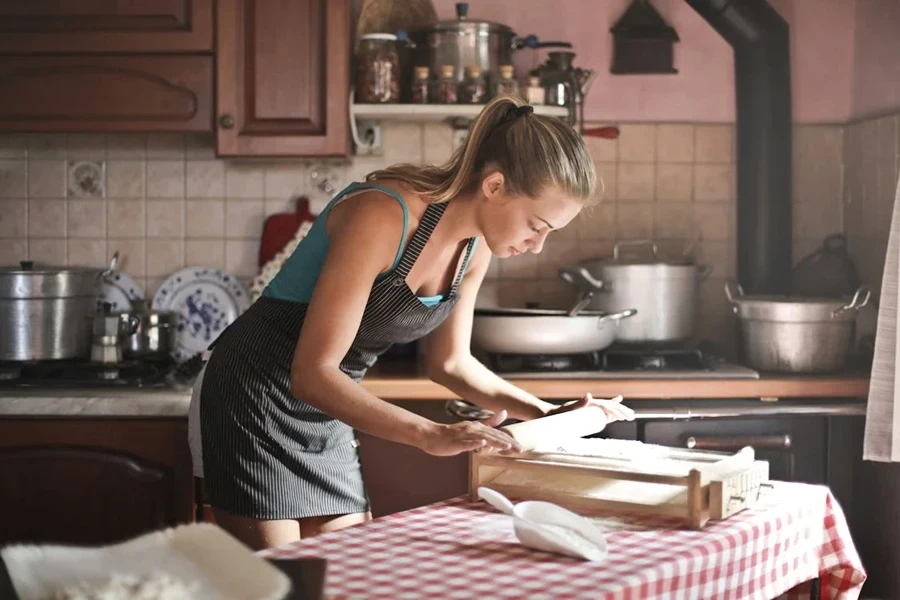Aprons have long served as essential tools in various professional environments, protecting clothing and assisting workers across industries from culinary arts to manufacturing. These versatile garments have evolved significantly, incorporating functional designs and materials tailored to specific tasks. Today, they are not only practical but also enhance efficiency and safety, making them indispensable in professional settings where precision and cleanliness are paramount. As the market continues to innovate, understanding the latest apron styles and their applications becomes crucial for selecting products that best meet the needs of different professions.
Table of Contents
1. Apron varieties and applications
2. Market dynamics for aprons
3. Key selection criteria for aprons
4. Top apron designs and their characteristics
1. Apron varieties and applications

Exploring different styles
Aprons serve as crucial tools in various industries, tailored to meet specific requirements of each profession. The diversity in apron styles accommodates the needs from kitchen to workshop. Bib aprons, a staple in culinary environments, provide extensive coverage from chest to knee, favoring chefs and bakers who face splatters and spills. The pinafore apron, characterized by its full coverage and lack of a bib, is preferred in settings where comfort and ease of movement are prioritized, such as in gardening or pottery.
Cross-back aprons eliminate the discomfort of neck straps by distributing weight across the shoulders, ideal for extended wear in kitchens or art studios. Meanwhile, waist aprons, which cover only the body from the waist down, are suited for servers and bartenders who need protection against spills while retaining mobility and style. These styles not only reflect the functional demands of various professions but also incorporate aesthetic preferences, merging utility with fashion in modern professional attire.

Usage across professions
The application of aprons extends beyond the culinary arts into realms where functionality and protection are paramount. Chefs and bakers, for whom quick and frequent access to tools is necessary, benefit from aprons with multiple pockets and durable materials like heavy cotton or denim. In the artistic domains, such as painting or sculpting, aprons need to be flexible and comfortable, often made from lighter materials like linen, which do not restrict movement.
Craftspeople, including carpenters and metalworkers, opt for aprons crafted from robust materials like leather that resist wear and provide substantial protection against tools and materials. The design elements of aprons, such as adjustable straps, reinforced pockets, and water-resistant fabrics, are carefully considered to enhance performance in specific tasks, illustrating the symbiotic relationship between apron form and professional function. This convergence of style, material, and utility underscores the evolving role of aprons in professional settings, ensuring both protection and productivity.
2. Market dynamics for aprons
Current market trends
The apron market is currently witnessing a dynamic shift, reflecting a broadening in application and consumer preferences. As businesses explore more specialized uses of aprons beyond traditional settings, demand patterns are evolving. The segmentation of the market now caters not only to the hospitality and healthcare sectors but also extends to industries such as art, fashion, and even tech, where aprons serve as functional attire for protecting personal clothing from occupational hazards.
In response to consumer demands for durability coupled with style, manufacturers are innovating with materials that offer both utility and aesthetic appeal. This shift is significantly influenced by the rising awareness among consumers who prioritize both the functional aspects of aprons and their environmental impact, leading to increased demand for eco-friendly materials.

Technological advancements
Technological innovations in the apron industry are pivotal in shaping the current market landscape. New materials such as oilcloth or PVC are being introduced, providing enhanced durability and resistance to various elements, which are crucial in settings like medical labs or food processing units. Additionally, the integration of smart technology into apron designs is becoming more prevalent. Features such as antibacterial finishes and fire-resistant fabrics are improving safety standards within workplace environments.
Design innovations are also prominent, with companies creating more ergonomic aprons that enhance user comfort and efficiency. These advancements not only improve the functionality of aprons but also contribute to market growth by broadening the scope of applications. For instance, lightweight, breathable fabrics are being used to construct aprons that are suitable for intense kitchen environments or bustling art studios, helping users maintain comfort over long periods.
This technological evolution drives the apron market forward, offering new opportunities for businesses to enhance their operational efficiencies while adhering to safety and health regulations. The strategic adoption of these innovations by key market players helps sustain their competitive edge and adapt to the changing demands of diverse professional landscapes.
3. Key selection criteria for aprons

Material considerations
When selecting aprons, the choice of material is paramount, as it impacts not only the durability and functionality of the apron but also its suitability for specific work environments. Cotton, known for its comfort and breathability, remains a popular choice in environments where comfort is essential and exposure to heavy soiling is minimal. Linen offers a lightweight alternative, highly valued in hot climates for its excellent moisture-wicking properties.
Denim, with its robust texture and high durability, stands as an ideal choice for more demanding settings, such as workshops or studios where manual work is performed. Denim aprons are appreciated for their ability to withstand rigorous use and frequent washing. On the other hand, synthetic fabrics, including polyester blends, are favored for their stain resistance and ease of maintenance. These materials often incorporate functionalities such as water resistance and fire retardance, making them suitable for industries that involve exposure to fluids or potential fire hazards.

Design and functional features
The design and functionality of an apron are critical to its performance. Features such as pockets are indispensable for professionals who need to keep tools and materials within easy reach. The configuration and depth of pockets must be considered to ensure that they meet the user’s needs without compromising comfort or efficiency.
Straps and their adjustability play a significant role in the overall comfort of the apron. Cross-back straps are increasingly popular for distributing weight more evenly, thereby reducing neck strain during prolonged use. Adjustable features, such as neck loops and waist ties, allow for a more customized fit, which is essential for maintaining freedom of movement and ensuring that the apron stays securely in place.
Additionally, the inclusion of features like ventilation panels, reinforced seams, and double-layering in high-wear areas can significantly enhance the functionality and longevity of an apron. These design elements are tailored to meet the specific demands of various professional settings, emphasizing the necessity of selecting an apron that is not only well-suited to the wearer’s tasks but also contributes to a safer and more productive work environment.
4. Top apron designs and their characteristics

Leading designs for 2024
The apron market in 2024 showcases several leading designs that stand out due to their innovative features and practical functions. These aprons are trending because they address the specific needs of professionals across various industries, combining utility with contemporary style. One popular trend is the use of ergonomic designs, such as cross-back straps, which distribute weight evenly across the shoulders and reduce neck strain during long hours of wear. This design is particularly favored in culinary and artisanal settings where comfort is paramount.
Another key feature driving the popularity of certain apron models is the incorporation of high-performance materials. These materials include advanced fabrics that are not only durable but also resistant to stains and spills, making them ideal for demanding environments like kitchens and workshops. Lightweight, breathable fabrics are also gaining traction, especially in settings that require prolonged apron use, ensuring that professionals stay cool and comfortable throughout their workday.
Customization options are another significant factor making these aprons popular. Many trending models offer adjustable straps and multiple pockets, allowing users to tailor the apron to their specific needs. These pockets are designed to be practical, providing ample space for essential tools and ensuring they are easily accessible. Furthermore, the aesthetic appeal of these aprons is enhanced through various color options and stylish patterns, catering to the preferences of modern professionals who value both function and fashion.

Feature comparison
A detailed comparison of the top apron models reveals several critical features that make them stand out. Durability is a fundamental attribute, with many aprons made from robust materials such as heavy-duty cotton, denim, or specialized synthetic blends. These materials are selected for their ability to withstand frequent washing and the wear and tear of intensive use, ensuring that the aprons remain functional and presentable over time.
Ease of cleaning is another important feature. Aprons designed for high-stress environments often feature stain-resistant and water-repellent coatings, which help maintain a clean and professional appearance even after exposure to spills and splatters. Machine-washable designs are particularly valued, as they simplify maintenance and extend the lifespan of the aprons.
The practical design of pockets and straps significantly enhances the functionality of these aprons. Deep, strategically placed pockets provide convenient storage for tools and personal items, reducing the need for additional storage solutions. Adjustable straps, especially those with quick-release buckles or sliding adjustments, allow for a customizable fit, accommodating various body types and preferences.
In addition to functionality, the aesthetic appeal of aprons plays a crucial role in their selection. Modern apron designs often feature sleek, minimalistic styles that align with contemporary professional environments. The availability of multiple colors and patterns allows users to choose aprons that reflect their personal style or complement their workplace branding, making these aprons a versatile and attractive option for a wide range of professionals.
Conclusion
The selection of an apron involves more than mere aesthetic consideration; it requires a thoughtful assessment of material, design, and functional features that align with specific professional demands. As the apron market continues to evolve, incorporating advanced materials and innovative designs, professionals must prioritize durability, ease of maintenance, and suitability for the work environment to ensure optimal performance. This approach not only enhances the functionality of aprons within various industries but also contributes to a safer, more efficient, and aesthetically pleasing work atmosphere.



